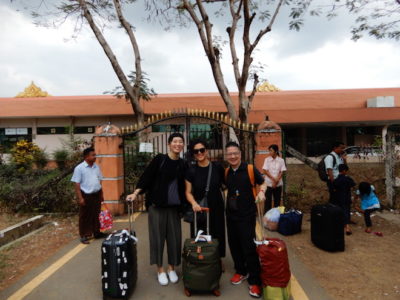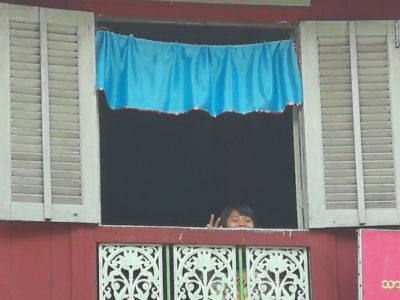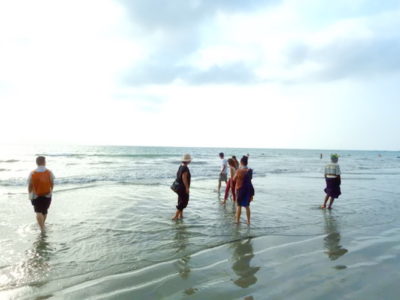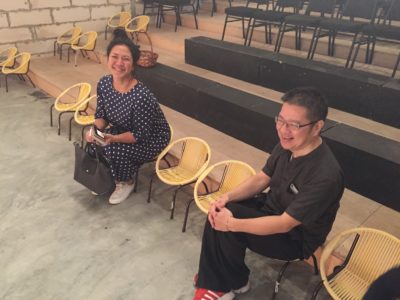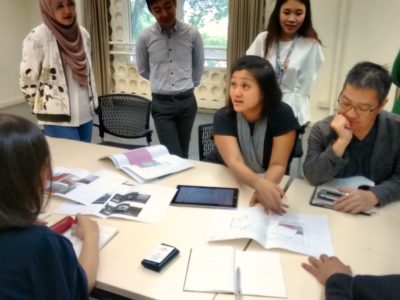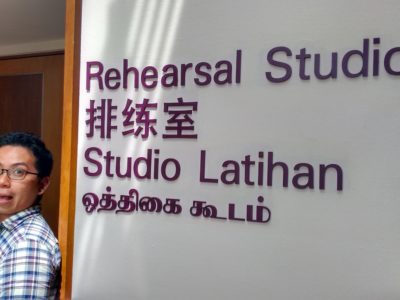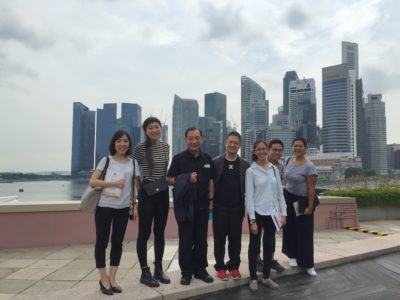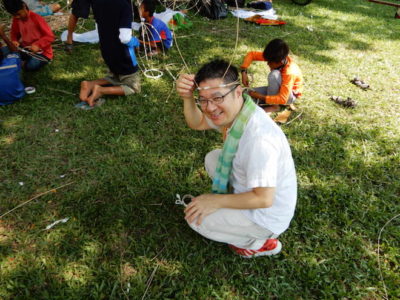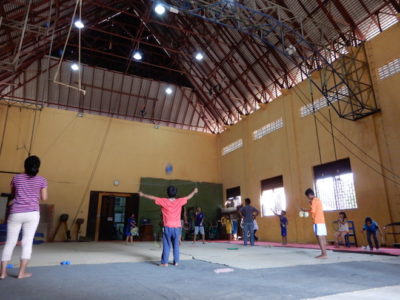Home » Research Visit Reports » Caleb Lee
Context
The research trip to Cambodia was phase 3 of the Asian TYA Network initiative to understand the creative and cultural ecologies of South East Asia countries with the aim to expand possible partnerships and future activities. Supported by the Japan Foundation Asia Centre, this 5-day trip after the team’s visit to Singapore and Kuala Lumpur, Malaysia, focused on 3 cities (Siem Reap, Battambang and Phnom Penh) in Cambodia. To understand the cultural contexts, government interventions, conditions of production and reception in Cambodia, one needs to acknowledge the country’s complex but rich history that overlays political unrest, economic revival and social struggles that its people face over time. Key historical moments include the French Colonial Period in the 1800s, Khmer Rouge in the 1970s, and the aftermath of the Vietnamese Occupation. Due to political unrest and struggles during the Khmer Rouge period, there was a decline in arts and culture. It is only in the recent years that the country has been experiencing artistic revival due to increased support from Non-Governmental Organizations (NGO), private funders and foreign tourists.
It is important to establish that leisure activities and entertainment in the main cities such as Siem Reap and Phnom Penh are largely driven by the active tourism industry. While the first two cities (Siem Reap and Battambang) focused mainly on the works of Phare Cambodian Circus, it became apparent that the success of this profit company has inspired and paved the way for many smaller performing arts groups to model after its strategic business structure that ensures sustainability. Dara, Chief Executive of Phare Cambodian Circus, shared that while profit making is one the company’s main objective, its secondary aim is to support the organization’s education platforms-Phare Ponleo Selpak (School of Performing Arts) through social enterprise activities. By understanding the business structures, practices and philosophies of Phare in relation to the socio-political landscape of Cambodia, it refracts some of the key practices, ideologies and challenges of the various companies, which in return reveals the social fabric of the Cambodian culture.
Education and Training
It is evident that there is a strong focus on education and nurturing creativity in the next generation as part of the country’s artistic revival. Majority of the groups that we visited stressed the importance of working with young people using arts as a vehicle for empowerment and advocacy. Bob Ruijzendral, Artistic Director of New Cambodian Artists (NCA,) shares this heartbeat and explained that his programme aims to bridge the traditional and contemporary dance for young dancers. Certified by the Ministry of Education, this programme pushes social boundaries by empowering the all-female troupe that blends traditional Apsara dance with contemporary dance sensibilities. In the same vein, Nick Coffill, Creative Director of Bambu Stage, also explained how the company provides a platform for puppet experimentation (led by head puppeteer, Soran) and live-media theatre. Though also a profit company, Bambu Stage stresses the importance of creative diversity and telling the traditional stories to contemporary audience in an accessible way. Soran currently works with a group of puppeteers to provide weekly public performances.
While students are given opportunities to engage in public performances, the core focus is still on the students’ holistic education. Erik Regnault, Executive Director of Phare Ponleo Selpak, shared that students are only allowed to perform if they attend classes regularly. This is to deter students from only focusing on performing and neglecting curriculum learning. Located in Battambang, this Phare Ponleo Selpak houses 1200 local students that live approximately 10km around the region. Students are expected to attend the public school (elementary and secondary) before they can enroll in the Phare’s professional programmes. These programmes include traditional dance, music, theatre and circus training that range from 4-6 years and are targeted at 14-15 years old students who can enroll full time in the programmes.
In addition, these courses are also offered as leisure curriculum for students still in public school. Alternatively, students can also choose to enroll in the visual arts, graphic design or animation programmes. In the evenings, there are also student public performances for tourists. The income through box office, merchandise and fund rasing are paid to the performers and also help fund the school. Perhaps, what is unique about (arts) education in Cambodia is that they are not only free for students, but ‘student performers’ are also paid to learn. What this means is that they are treated as professional performers and are paid a salary for each performance as an incentive to keep honing their craft and practice.
In Phnom Penh, it is heartening to learn that Nico Mesterharm, Director of Meta House, has pilot a ‘school theatre’ initiative in 2015. This theatre-in-education model involves bringing an educational theatre performance to local communities. Nico shared that the facilitators, actors, script writers are all Cambodians and that the performance deals with social messages such as the dangers of underage drinking and drink driving. Given the context that the Cambodian education system is didactic and rigid, these theatre interventions have proven very popular as they provide an alternative form of expression and learning. To ensure the continuity of these project, Meta House has been working very closely with donors, youth NGOs and the Ministry of education. This has been proven effective as the project has now reached 30,000 students in the rural areas, with another troupe being recently formed in 2016 to focus on follow up activities such as exhibitions and creative education. While the ministry is in strong support of the project, the main challenge is that schools are unwilling to coordinate them. A strategy undertaken by Meta House is to work with a government official from the Ministry to deal with the school directly to ensure that such projects are successfully delivered without the administrative hassle. This allows the company to focus on the creative and education process. On an organization front, since Meta House is not part of the Goethe Institute, Nico has the flexibility and freedom in his programming. He hopes to work with partners and drama groups to further enhance the ‘school theatre’ platform in the future.
With the same vision to provide a safe and positive environment to for at-risk children and youth, Shhort, General Manager of Tiny Toones, shared that his aim is to help build confidence and future employment for young people through ‘education and creation’. Established in 2005 by his partner ‘KK’, this education institution provides free learning (Language, Math, Computing, Dance, Music and Arts) for approximately 100 students living in the community. The centre offers free transportation to students who live as far as 40 minutes away. This is not only evident of the institution’s commitment to the children but also ensures that students are able to enjoy education without geographical restrictions. Shhort shares that his aim is to provide equal opportunities and to get the students back into the public school system. He believes in an open door policy and stresses that children learn best from each other. Hence, students are often encouraged to express themselves creatively within safe boundaries of shared classes. The students have been successful in professional hip hop performances, events and the media. Currently, the school relies on the funds from the Asian Community Trust, private donors, occasional fund raising activities which is barely sustainable. Turning to social enterprise strategies, they recently started a bar (The Cool Lounge) with a dance space to help raise extra funds for the running of the school. Shhort hopes that his students will be able to be involved with more international cultural exchanges to widen their perspective. He acknowledges that the ambitions of children in Cambodia are slowly changing with more eager to find opportunities internationally.
Community Building
Apart from understanding some the business structures of profit companies, what was heartening in Siem Reap was to observe some strong ground-up and grassroots initiatives. One positive experience was the visit to the creation process of The Giant Puppet Project. Led by various NGOs, students and artists work intensively for two weeks to build giant puppets that they parade down the streets annually. While a team of artists take the lead to design these puppets, children are encouraged to express their creativity by building and creating objects such as hats and props as a way of self-expression. Not only do the children learn the craft of making such puppets, but through the communal experience, children also learn intangible skills such as collaboration and team work. This initiative is again evident that there is a desire to empower children through the use of arts.
On the organization front, Stewart shared that rather than sticking to the traditional top-down hierarchy, he aims to flatten out the management structure in order to encourage more organic growth and sustainability. He feels that a flexible structure takes the pressure off “one main artist/director” and gives opportunities to other artists to take the lead. In addition, to ensure that the artists are not exploited, they are paid a salary for the project. Importantly, to steer clear from government intervention, this project is kept independent, relying on non-government organizations, support from local businesses (monetary and in-kind) and public donations. This methodology appears effective given the parade’s ability to sustain itself for a decade. Perhaps, the most positive outcome from this project is that it creates new audiences that continue to build and support arts and culture over time. Stewart shares that over the years, past participants continue to support the project. One suggestion was that the children could also take ownership of designing their own puppets in future projects.
Sustainability and Space
Due to the lack of government support and funding, many groups in Siem Reap are constrained and are driven by the “Hotel Culture”. This means that many groups perform in hotels for tourists. In addition, there are limited dedicated performance venues. For example, NCA shares that they perform in hotels to earn revenue to sustain themselves, Phare and Bamubu Stage’s also shared that their main target audiences are tourists. All these signify a more commercial slant in the conditions of productions of the groups. While there is a strong desire to break away from the suffocating tourism market, there is a struggle for sustainability and survivability due to market forces and the nature of such demands. This also means that there is strong reliance on tourist audience and performances are sometimes created to meet the need of these expectations. To make matters worse, the demand for such performances are decreasing, thus contributing to already struggling groups.
Between Traditional and Professional ‘Theatre’
This visit to Phnom Penh allowed the team to meet with Cambodian Living Arts to understand the state of traditional arts and the struggles they are facing. There is an anxiety and clear emphasis from the group to preserve ‘yike theatre’- a form of traditional theatre that includes dancing and singing. Starting off as ‘yike dance’, it evolved into ‘yike theatre’ where contemporary troupes are mostly hired to perform in villages for any occasion. The audience demography range from young to old. However, due to the lack of demand, it has been increasingly challenging to form skilled troupes to preserve this tradition. In addition, many performers are also unwilling to learn this art form. While there have been attempts to contemporize ‘yike theatre’, there is a conscious effort to preserve the core elements such as the use of traditional drums, song and dance, as the company strongly feels that ‘yike’ represents the Cambodian identity.
On the other spectrum, ‘modern spoken theatre’ is also facing the same challenge. Established in 1958, the Royal University of Fine Arts offered training in ‘modern spoken theatre’. This form modelled after the French theatre traditions and was adapted to Cambodian culture. Similar to ‘yike theatre’, due to the decreasing popularity, the programme is struggling to attract the next generation of practitioners. It is disheartening to learn that there are currently only 14 students with only 6 qualified to perform professionally. There is a social stigma that there is no career trajectory for such profession and that income would be the biggest problem. As a result, most are willing to do it only at the side for ‘fun’. This is further aggravated due to lack of corporate sponsors and government support that demoralizes the artists.
To resist these challenges, it is also apparent that there is a trend to reinvent and contemporize the traditional in order to remain relevant and to make the Cambodian art forms accessible to the new generation and tourist audiences. Similar to most groups, Sophiline Arts Ensemble shared that their work tackle issues of identity and social problems. Sophiline, Artistic Director of the troupe, shared that there is a need to revitalize the art form in order for it to engage and connect with new audiences. Working with a core team of 25 dancers, the productions are influenced by her training in UCLA and approaches to western theatre-making. These productions often include the use of set, light and costumes, while trying to maintain traditional gestures and movements.
With a history of 25 years, Sovanna Phum Arts Association and Gallery, a troupe that practices shadow puppetry, shares that this vanishing art form is facing competition from other popular entertainments and media. The company puts up 2-3 performances a week that again targets at tourists and visitors. In order to engage and make the performance accessible to the audience, the performances combine puppet, dance and mask. The performance that we watched seemed to prioritize aesthetics and spectacle over narrative. This new ways of approaching creativity are again indicative of how traditional forms are being reinvented to cope with the socio-political struggles in the arts.
Awareness and Accessibility
On a positive note, there have been innovative ways of partnership across companies to create awareness and advocacy. For example, Cambodian Living Arts have worked with Krousar Thmey, a foundation for underprivileged children, to train blind and deaf children in ‘yike theatre’ as a strategy to raise social awareness. Consisting of 17 students, these performances are presented in remote areas of Cambodia to a range of audiences. Not only does it revive a traditional form, but it also uses it as a vehicle to empower the underprivileged children and to spread social messages in rural areas. This innovative use of traditional arts, advocacy and empowering the underprivileged is an excellent initiative and idea that responds to the socio-cultural struggles.
Sharing the same sentiments, Onn Sokny from Epic Arts shared that 7% of the population in Cambodia suffers from disability and experience a negative social stigma placed on them. This means that they are often discriminated and do not share equal opportunities. As a result, integrating back into society becomes a challenge, which result in increasing frustrations and low morale. Similar to the inclusive model of ‘arts for all’ from the UK, Epic Arts believes that contemporary arts and theatre provide a platform for freedom of expression and empowerment for the less fortunate. This not only helps build artistic and personal development in these people, but also help create social impact in society. This two-year programme haven been successfully commissioned by local and international companies to produce collaborative works. In return, this expands Epic Art’s networks, outreach and efficacy of social impact.
Government Funding and Support
All groups that we visited echoed the same sentiment that government funding for the arts is almost non-existent in Cambodia. As a result, many groups have to rely on small grants, public donations and hotel performances to sustain themselves; more often than not, these funds and income are insufficient. A possible reason for the government’s unwillingness to invest in this area is the present economic limitations and political struggles. Only slightly larger companies such as Phare have the capacity to employ social enterprise strategies for sustainability.
Groups also shared that currently there is a limited theatre identity and culture. This means that the public do not understand the philosophy of paying for tickets to attend performances. The general perception is that traditional performances should be non-ticketed due to the Cambodia’s historical patronage culture where these performances were usually fully sponsored. By extension this also means that there is no proper ‘theatre’ mechanism such as marketing, publicity and box office sales to sustain groups.
Overall Reflections
Given the context that there is a limited ‘theatre’ culture, by extension, the concept of how TYA is understood in Singapore, Malaysia and most (western) creative cities is almost non-existent in Cambodia. Theatre and traditional performances are mostly aimed at a wide range of audience for various occasions. That said, while there is no clear intention from groups to create performances specifically aimed at children and young people for sustainable reasons, the underlying principles of TYA already exists but without a fixed definition. For example, groups such as Sovanna Arts and Phare Ponleo Selpak shared that they allow the local communities and children to watch the performances for free after all ticket patrons have been seated. In addition, performers are encouraged to invite friends to watch the performances during low tourist seasons. What this means is that audience development is already present in Cambodia culture but through a more organic and ground up approach. Furthermore, there is a very strong emphasis placed on working with and empowering young people through arts and education. The idea of working ‘with’ and ‘by’ young people is very evident in the activities and initiatives of the most groups. In addition, groups such as Tiny Toones and Phare Ponleo Selpak shared that most of their teaching staff were former students, which is indicative that there is effective impact through the engagement of arts.
Since singing, dancing, arts and craft is embedded in the rich history and cultural fabric of Cambodian society, the citizens are inherently creative and artists in their own rights. It is disheartening to learn that due to limited opportunities and funding, many of them are unable to further pursue a career in the arts. One peculiar observation is that majority of the leadership positions are held by the non-local community for most of the groups we visited. While they all share a positive vision to use arts to help empower young people, I question if there is an exit mechanism for such structures in order for local communities to eventually occupy these spaces to deepen the engagement and connecting local knowledge with their lived experiences. One interpretation of this situation is that currently local artists are heavily reliant on the non-local ‘leaders’ for directions, employment and creative opportunities.
Unlike the trips to Singapore and Malaysia where cultural sensibilities and artistic expectations were closer, there is no fixed outcome, solution or a distinct model of collaboration for Cambodia. Perhaps, a tangible starting point is to help support and enhance spaces, infrastructures and equipment so that young people can continue to develop themselves as artists- not as charity but for change. It is evident to this research team that there is a strong desire, passion and commitment to the arts from the young people in Cambodia. Taking a step back, it is also important to consider the significance and function of the Asian TYA Network and how it can transform to become a network of hope. At the heart of it, successful partnerships happen between like-minded individuals and not organizations. Given the rapidly changing culture in most of the countries, it is highly urgent that TYA practitioners of South-East Asia continue to participate and engage with complex context and ‘messy realities’ of communities, theatre, tradition, artistic practices, education and young people. Social change can only happen through multiple voices, flows and networks of understandings. By opening up these spaces for cultural education and exchange through activities such as research trips, we can gain a shift in perspective in regions with different socio-political backdrops and situated histories. It is only then that we can rethink and challenge the role of theatre for young people in the second decade of the 21st Century in these regions.
Report by: Caleb Lee (Independent Producer and Researcher)




